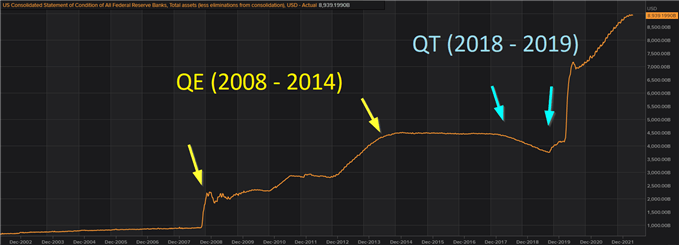What is Quantitative Tightening?
Quantitative tightening (QT) is a contractionary monetary policy tool used by central banks to reduce the level of money supply, liquidity and general level of economic activity in an economy.

You may be asking yourself why any central bank would wish to lower the level of economic activity. They do so begrudgingly when the economy overheats, causing inflation, which is the general increase in the prices of goods and services typically purchased in the local economy.



The Good and Bad Side of Inflation
Most developed nations and their central banks set a moderate inflation target around 2% and that is because a gradual increase in the general level of prices is integral to stable economic growth. The word ‘stable’ is key because this makes forecasting and future financial planning easier for individuals and businesses.
Inflation and the Wage-Price Spiral
However, runaway inflation can easily get out of hand when workers lobby for higher wages due to higher inflation expectations, a cost that businesses pass on to consumers via higher prices which reduces consumers’ purchasing power, ultimately leading to further wage adjustments and so on.

Inflation is a very real risk of quantitative easing (QE), a modern monetary policy tool comprised of large-scale asset purchases (usually some combination of government bonds, corporate bonds and even equity purchases) used to stimulate the economy in an attempt to recover from a deep recession. Inflation can result from over stimulation which may necessitate quantitative tightening to reverse the negative effects (surging inflation) of QE.
Foundational Trading Knowledge
Forex Fundamental Analysis
Learn More About the Importance of Central Banks
How Does Quantitative Tightening Work?
Quantitative tightening is the process whereby a central bank sells its accumulated assets (mainly bonds) in order to reduce the supply of money circulating in the economy. This is also referred to as ‘balance sheet normalization’ – the process whereby the central bank reduces its inflated balance sheet.
Objectives of Quantitative Tightening:
- Reduce the amount of money in circulation (deflationary)
- Raise borrowing costs alongside the rising benchmark interest rate
- Cool down the overheating economy without destabilizing financial markets
QT can be done via bond sales in the secondary treasury market and if there is a sizeable increase in the supply of bonds, the yield or interest rate required to entice buyers tends to rise. Higher yields raise borrowing costs and lowers the appetite of corporations and individuals that had previously borrowed money when lending conditions were generous and interest rates were near (or at) zero. Less borrowing results in less spending, leading to lower economic activity which, in theory, leads to a cooling of asset prices. Additionally, the bond selling process removes liquidity from the financial system forcing businesses and households to be more cautious with their spending.
Quantitative Tightening vs Tapering
‘Tapering’ is a term often associated with the quantitative tightening process but actually describes the transitional period between QE and QT whereby large-scale asset purchases are cut back or ‘tapered’ before coming to a complete halt. During QE, maturing bond proceeds tend to be reinvested in newer bonds, pumping even more money into the economy. Tapering, however, is the process whereby reinvestments are cut back and eventually come to a halt.
The terminology ‘tapering’ is used to describe the smaller incremental additional asset purchases which is not ‘tightening’ but simply easing off on the rate at which assets are being purchased by central banks. For example, you wouldn’t describe lifting your foot off the gas pedal as breaking even though the car will start to slow down, assuming you are on a flat road.
Examples of Quantitative Tightening
Since QE and QT are fairly modern policy tools, there really hasn’t been a lot of opportunity to explore QT. The Bank of Japan (BoJ) was the first central bank to implement QE but has never been able to implement QT due to stubbornly low inflation. 2018 was the only time the US implemented QT only to be discontinued less than a year later in 2019 citing negative market conditions as the reason for its abrupt end. In 2013, Fed Chairman Ben Bernanke’s mere mention of tapering sent the bond market into a spin, delaying QT until 2018 alluded to above. Therefore, the process is largely untested as the program was cut short.
Since 2008 the Federal Reserve has amassed $9 trillion on its balance sheet, only having reduced the figure slightly between 2018 and 2019. Since then, it has been one way traffic.
Accumulation of the Fed’s Assets over time (Peak just shy of $9 trillion)

Source: St. Louis Fed
The Potential Drawbacks of Quantitative Tightening
Implementing QT involves striking a delicate balance between removing money from the system while not destabilizing financial markets. Central banks run the risk of removing liquidity too quickly which can spook financial markets, resulting in erratic movements in the bond or stock market. This is exactly what happened in 2013 when the Federal Reserve Chairman Ben Bernanke merely mentioned the possibility of slowing down asset purchases in the future which resulted in a massive spike in treasury yields sending bond prices lower in the process.
US Treasury Yields Weekly Chart (orange 2yr, blue 5yr and 10 year yields)

Such an event is called a ‘taper tantrum’ and can still manifest during the QT period. Another drawback of QT is that it hasn’t ever been carried out to completion. QE was implemented after the Global Financial Crisis in an attempt to soften the deep economic recession that ensued. Instead of tightening after Bernanke’s comments, the Fed decided to implement a third round of QE until more recently, in 2018, the Fed began the QT process. Less than a year later the Fed decided to end QT due to negative market conditions witnessed. Therefore, the only example to go by suggests that future implementation of QT could very well result in negative market conditions once again.






